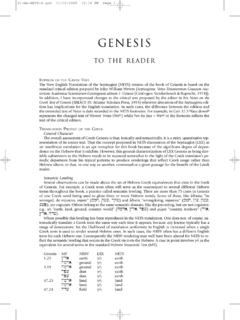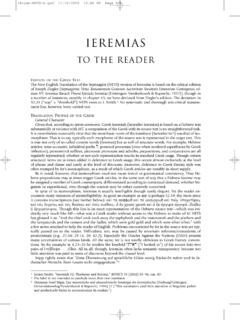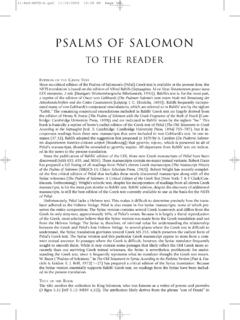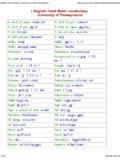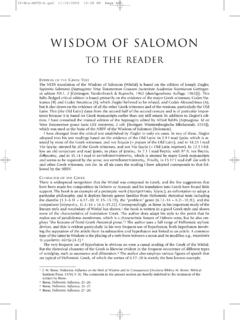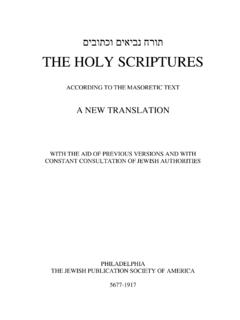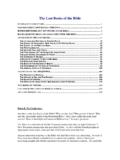Transcription of PSALMS OF SALOMON
1 EDITION OF THEGREEKTEXTS ince no critical edition of the PSALMS of SALOMON s (PsSal) Greek text is available at the present time, theNETS translation is based on the edition of Alfred Rahlfs (Septuaginta. Id est Vetus Testamentum graece iuxtaLXX interpretes, 2 vols.[Stuttgart: W rttembergische Bibelanstalt, 1935]). Rahlfs s text is, for the most part,a reprint of the edition of Oscar von Gebhardt (Die Psalmen Salomo s zum ersten Male mit Benutzung derAthoshandschriften und des Codex Casanatensis[Leipzig: J. C. Hinrichs, 1895]). Rahlfs frequently incorpo-rated many of von Gebhardt s conjectural emendations, which are referred to in Rahlfs text by the siglum Gebh. The remaining conjectural emendations included in Rahlfs Greek text are largely derived fromthe edition of Henry B.
2 Swete (The PSALMS of Solomon with the Greek Fragments of the Book of Enoch[Cam-bridge: Cambridge University Press, 1899]) and are indicated in Rahlfs notes by the siglum Sw. Thisbook is basically a reprint of Swete s earlier edition of the Greek text of PsSal (The Old Testament in GreekAccording to the Septuagint[vol. 3; Cambridge: Cambridge University Press, 1894] 765 787), but it in-corporates readings from three new manuscripts that were included in von Gebhardt s text. In one in-stance ( ), Rahlfs adopted the suggestion first proposed in 1870 by A. Carri re (De Psalterio Salomo-nis disquistionem historico-criticam scripsit[Strasbourg]) that xristo_j ku/rioj, which is preserved in all ofPsSal s manuscripts, should be emended to xristo_j kuri?
3 Departures from Rahlfs text are indicat-ed in the notes to the present the publication of Rahlfs edition of the LXX, three new Greek manuscripts of PsSal have beendiscovered (MSS 655, 659, and 3004). These manuscripts contain no major textual variants. Robert Hannhas prepared a full listing of all readings from PsSal s eleven Greek manuscripts (The Manuscript Historyof the PSALMS of Solomon[SBLSCS 13; Chico: Scholars Press, 1982]). Robert Wright has recently complet-ed the first critical edition of PsSal that includes these newly discovered manuscripts along with all theSyriac witnesses (The PSALMS of Solomon: A Critical Edition of the Greek Text[New York: T & T Clark/Con-tinuum, forthcoming]). Wright s eclectic text, despite his incorporation of readings from all eleven Greekmanuscripts, is for the most part similar to Rahlfs text.
4 Rahlfs edition, despite the discovery of additionalmanuscripts, is still the best edition of the Greek text currently available to use as the basis for the NETSof , PsSal lacks a Hebrew text. This makes it difficult to determine precisely how the trans-lator adhered to the Hebrew is also extant in five Syriac manuscripts, none of which pre-serves the entire composition. The Syriac version contains several Greek loanwords and differs from theGreek in only sixty-two, approximately 10%, of PsSal s verses. Because it is largely a literal reproductionof the Greek, most scholars believe that the Syriac version was made from the Greek translation and notfrom the Hebrew Syriac is, therefore, of minimal value for understanding the relationshipbetween the Greek and PsSal s lost Hebrew several places where the Greek text is difficult tounderstand, the Syriac translation gravitates toward Greek MS 253, which preserves the earliest form ofPsSal s Greek text.
5 The Syriac version and this particular Greek manuscript appear to stem from a com-mon textual ancestor. In passages where the Greek is difficult, however, the Syriac translator frequentlysought to smooth them. While it may contain some passages that likely reflect the Old Greek more ac-curately than our surviving Greek textual witnesses, the Syriac is nevertheless problematic for under-standing the Greek text, since it frequently represents what its translator thought the Greek text Baars ( PSALMS of Solomon, in The Old Testament in Syriac According to the Peshitta Version[Part 4, Fas-cicle 6; Leiden: E. J. Brill, 1972] 1 27) has prepared a critical edition of the Syriac translation . Becausethe Syriac version essentially supports Rahlfs Greek text, no readings from the Syriac have been includ-ed in the present OF THEBOOKThe title ascribes the collection to King SALOMON , who was famous as a writer of poems and proverbs(3 Rgns [MT ; NRSV ]).
6 The attribution likely derives from the phrase son of Dauid inPSALMS OF SALOMONTO THE 11/10/2009 10:39 PM Page 763764to the reader of PSALMS of , apparently thought by some scribe to mean SALOMON . Superscripts of individual PSALMS too aregenerally thought to be secondary. Whether they were already in the translator s Hebrew source text isnot at all manuscripts title the collection PSALMS of SALOMON , whereas others give the name as Solomon. In manuscript 253 (XI/XII CE), which contains the best and earliest text, has Solomon in the title, but SALOMON in all but three of the superscripts. Other Greek manuscripts vary earliest attestation to a title is in Codex Alexandrinus (V CE), which reads (YALMOISOLOMWNTOS).
7 Since this listing is nearly five centuries later than PsSal s presumed first centuryBCE date of composition, it does not resolve the debate over the correct spelling of the name. Thespelling of Codex Alexandrinus appears in many later Christian canon lists, such as those of Pseudo-Athanasius (early VI CE) and Nicephorus (IX CE), suggesting that Solomon was the preferredspelling during the Christian period. Although Rahlfs text consistently uses the spelling SALOMON forthe superscripts, he titled the collection PSALMS of Solomon. Because the LXX of Reigns uses thespelling SALOMON , this was likely the spelling used in the Old Greek if indeed it had any title atall and is used throughout NETS of OF THEGREEKB ecause we do not possess PsSal s Hebrew Vorlage, it is difficult to attempt to reconstruct its original is, moreover, impossible to determine with any certainty whether the Greek translator remained faith-ful to the original text or sometimes expanded or paraphrased the Hebrew.
8 In some instances the Greektranslator may have improperly vocalized his Hebrew text or closely adhered to Hebrew syntax, whichsometimes resulted in an awkward keeping with the philosophy of NETS, the present english translation of PsSal has attempted tofocus on the Greek translator s intent rather than on the perception of the original audience. In otherwords, the english has tried to adhere to the NRSV s maxim to be as literal as possible, as free as nec-essary. Where the Greek translator likely did not understand the original Hebrew, or possibly mis-translated what was likely the Vorlage, the english translation seeks to convey the ambiguity of translation OF THEPSALMS OFSALOMONB ecause there is no Hebrew text of PsSal to compare with the Greek, it is difficult to comment in detailon the Greek translator s methods.
9 PsSal s relatively limited Greek vocabulary suggests that the translatorrarely departed from a fixed list of Hebrew-Greek equivalents. It appears that the translator frequentlyused the same word, such as o3siojand e1leoj, to represent a given Hebrew word even in instances whenanother Greek word would have been more appropriate. This lexical stereotyping often resulted in arather stilted translation , which in many cases likely reflects the appearance of the Hebrew Vorlage. PsSal sGreek text also contains renderings in which the translator apparently attempted to express the meaningof the Hebrew at the expense of achieving a clear Greek reading. In some instances, such as a1nacij ( )and a)na/lhmyij( ), the exact Hebrew to Greek equivalent is uncertain.
10 There is some evidence thatlater Christian scribes introduced errors into the text. In , for example, the original genitive kuri/ouwas likely erroneously rendered as a nominative by a later Christian scribe resulting in two anarthrousnominatives (xristo_j ku/rioj). This same reading is also found in the LXX of Lam These exampleslikely reflect messianizing changes that were later made to the LXX in the Christian era. In the absence ofPsSal s Hebrew Vorlage, it is impossible to know for certain how extensively later scribes altered its origi-nal several places it appears that PsSal s translator has either confused the Hebrew consonants or mis-understood Hebrew grammar. In , for example, the translator apparently misread an originalrymhl ( to change, turn ) as rm)l( to say ).
